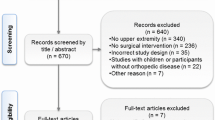Abstract
The view that subjective complaints rather than “objective” measurements decide on whether to consult the doctor or allow for an intervention to be carried out, should contribute to the decision-making process. This is especially true in diseases with multiple joint impairments. Although a variety of patient self-assessment scores exists, no gold standard is available to measure function and quality of life (QoL) after interventions at the upper extremity. The goal of our concept is to establish a comprehensive score set where patients should rate their generic health resp. quality of life (QoL), function of the upper extremity and specific joint function including activities of daily living, function and pain. A comparison with normative data should be possible in order to estimate how the subjective results of the patient when compared to “healthy” people in the general population. Score sets for measuring intervention effect at the shoulder, elbow and the hand were established after previous methodological testing within an interdisciplinary research project. The provisional sets were defined following a systematic literature search. Each set received a score of measuring the quality of life (SF-36), the whole function of the arm (DASH) and the specific joint function (SPADI/ASES for shoulder, PREE/mASES for the elbow and PRWE/custom for the hand). Individual scores were translated, if necessary according to AAOS-guidelines, and tested for reliability and construct validity. All three score sets were then systematically tested in cross-sectional studies. In addition, characteristic values such as minimal detectable difference and effect size could already be determined in the shoulder set in a long-term study. Definite score sets were defined, which allow quantification of the intervention effect at the upper extremity on function and quality of life after.
Similar content being viewed by others
References
American Association of Orthopedic Surgeons A (2002) The DASH-Outcome Measure: user’s manual. http://www3.aaos.org/research/normstudy
Angst F, Aeschlimann A, Steiner W, Stucki G (2001) Responsiveness of the WOMAC osteoarthritis index as compared with the SF-36 in patients with osteoarthritis of the legs undergoing a comprehensive rehabilitation intervention. Ann Rheum Dis 60(9):834–840
Angst F, Goldhahn J, Drerup S, Aeschlimann A, Schwyzer HK, Simmen BR (2008) Responsiveness of six outcome assessment instruments in total shoulder arthroplasty. Arthritis Rheum 59(3):391–398
Angst F, Goldhahn J, John M, Herren DB, Simmen BR (2005) Vergleich des rheumatischen und posttraumatischen Ellenbogengelenks nach Totalprothese. Eine umfassende sowie spezifische Beurteilung von Klinik, Funktion und Lebensqualität. Orthopade 34(8):794–800
Angst F, Goldhahn J, Pap G, Mannion AF, Roach KE, Siebertz D, Drerup S, Schwyzer HK, Simmen BR (2007) Cross-cultural adaptation, reliability and validity of the German Shoulder Pain and Disability Index (SPADI). Rheumatology (Oxford) 46(1):87–92
Angst F, John M, Goldhahn J, Herren DB, Pap G, Aeschlimann A, Schwyzer HK, Simmen BR (2005) Comprehensive assessment of clinical outcome and quality of life after resection interposition arthroplasty of the thumb saddle joint. Arthritis Rheum 53(2):205–213
Angst F, John M, Pap G, Mannion AF, Herren DB, Flury M, Aeschlimann A, Schwyzer HK, Simmen BR (2005) Comprehensive assessment of clinical outcome and quality of life after total elbow arthroplasty. Arthritis Rheum 53(1):73–82
Angst F, Pap G, Mannion AF, Herren DB, Aeschlimann A, Schwyzer HK, Simmen BR (2004) Comprehensive assessment of clinical outcome and quality of life after total shoulder arthroplasty: usefulness and validity of subjective outcome measures. Arthritis Rheum 51(5):819–828
Angst F, Stucki G, Aeschlimann A (2003) Quality of life assessment in osteoarthritis. Expert Rev Pharmacoeconom Outcomes Res 3(5):623–636
Beaton DE, Bombardier C, Guillemin F, Ferraz MB (2000) Guidelines for the process of cross-cultural adaptation of self-report measures. Spine 25(24):3186–3191
Beaton DE, Wright JG, Katz JN (2005) Development of the QuickDASH: comparison of three item-reduction approaches. J Bone Joint Surg Am 87(5):1038–1046
Bullinger M, Kirchberger I (1998) SF-36 Fragebogen zum Gesundheitszustand. Hogrefe-Verlag GmbH, Göttingen, p 155
Constant CR, Murley AH (1987) A clinical method of functional assessment of the shoulder. Clin Orthop Relat Res 214:160–164
Dowrick AS, Gabbe BJ, Williamson OD, Cameron PA (2006) Does the disabilities of the arm, shoulder and hand (DASH) scoring system only measure disability due to injuries to the upper limb? J Bone Joint Surg Br 88(4):524–527
Fitzpatrick R, Davey C, Buxton MJ, Jones DR (1998) Evaluating patient-based outcome measures for use in clinical trials. Health Technol Assess 2(14(i–iv)):1–74
Garratt A, Schmidt L, Mackintosh A, Fitzpatrick R (2002) Quality of life measurement: bibliographic study of patient assessed health outcome measures. Bmj 324(7351):1417
Gartland JJ (1988) Orthopaedic clinical research. Deficiencies in experimental design and determinations of outcome. J Bone Joint Surg Am 70(9):1357–1364
Goldhahn J, Angst F, Drerup S, Pap G, Simmen BR, Mannion AF (2008) Lessons learned during the cross-cultural adaptation into German of the American Shoulder and Elbow Surgeons (ASES) shoulder form. J Shoulder Elbow Surg 17(2):248–254
Goldhahn J, Drerup S, Simmen BR (2006) Automated processing of questionnaires as a prerequisite for large studies and quality management. 14th European Rheumatoid Arthritis Surgical Society Meeting (ERASS). J Bone Joint Surg (Br) 88-B(Supp II):209, Pfäffikon/Schweiz
Goldhahn J, Kolling C, Gay S, Simmen BR (2007) Functional staging and surgical intervention of the elbow and shoulder joints in a patient with rheumatoid arthritis. Nat Clin Pract Rheumatol 3:112–117
Gummesson C, Ward MM, Atroshi I (2006) The shortened disabilities of the arm, shoulder and hand questionnaire (QuickDASH): validity and reliability based on responses within the full-length DASH. BMC Musculoskelet Disord 7:44
Hudak PL, Amadio PC, Bombardier C (1996) Development of an upper extremity outcome measure: the DASH (disabilities of the arm, shoulder and hand) [corrected]. The Upper Extremity Collaborative Group (UECG). Am J Ind Med 29(6):602–608
Jaeschke R, Singer J, Guyatt GH (1989) Measurement of health status. Ascertaining the minimal clinically important difference. Control Clin Trials 10(4):407–415
John M, Angst F, Pap G, Junge A, Flury MP, Schwyzer HK, Simmen BR, Mannion AF (2007) Cross-cultural adaption, reliability and validity of the PREE (Patient Rated Elbow Evaluation) for German-speaking patients. Clin Exp Rheumatol 25(2):195–205
Karnezis IA, Fragkiadakis EG (2002) Association between objective clinical variables and patient-rated disability of the wrist. J Bone Joint Surg Br 84(7):967–970
Kirkley A, Griffin S, Dainty K (2003) Scoring systems for the functional assessment of the shoulder. Arthroscopy 19(10):1109–1120
Kurth BM, Ellert U (2002) The SF-36 questionnaire, its usefulness in population studies: results of the German Health Interview, Examination Survey. Soz Praventivmed 47(4):266–277
MacDermid JC (1996) Development of a scale for patient rating of wrist pain and disability. J Hand Ther 9(2):178–183
MacDermid JC (2001) Outcome evaluation in patients with elbow pathology: issues in instrument development and evaluation. J Hand Ther 14(2):105–114
Offenbaecher M, Ewert T, Sangha O, Stucki G (2002) Validation of a German version of the disabilities of arm, shoulder, and hand questionnaire (DASH-G). J Rheumatol 29(2):401–402
Portney LG (2000) Statistical measures of reliability. In: Portney LG, Watkins MP (eds) Foundation of clinical research: Applications to practice, 2nd edn. Prentice Hall Health, New Jersey
Richards RR et al (1994) A standardized method for the assessment of shoulder function. J Shoulder Elbow Surg 3:347–352
Roach KE, Budiman-Mak E, Songsiridej N, Lertratanakul Y (1991) Development of a shoulder pain and disability index. Arthritis Care Res 4(4):143–149
Sangha O, Stucki G, Liang MH, Fossel AH, Katz JN (2003) The self-administered comorbidity questionnaire: a new method to assess comorbidity for clinical and health services research. Arthritis Rheum 49(2):156–163
Simmen BR, Bogoch ER, Goldhahn J (2008) Surgery insight: orthopedic treatment options in rheumatoid arthritis. Nat Clin Pract Rheumatol 4(5):266–273
Stucki G, Grimby G (2004) Applying the ICF in medicine. J Rehabil Med 36(44 Suppl):5–6
Theiler R, Spielberger J, Bischoff HA, Bellamy N, Huber J, Kroesen S (2002) Clinical evaluation of the WOMAC 3.0 OA Index in numeric rating scale format using a computerized touch screen version. Osteoarthritis Cartilage 10(6):479–481
Ware JE, Snow KK, Kosinski M, Gandek B (1993) SF-36 health survey—manual and interpretation guide. QualiMetric Incorporated, Lincoln
Acknowledgments
The authors would like to thank Susann Drerup for her reliable management of data, patient administration and improvement of the infrastructure, PD Dr. Anne Mannion for her help in the translation process, Dr Michael John for his temporary help, Charles McCammon for translation, and the Georg and Bertha Schwyzer-Winker foundation for the generous financial support.
Author information
Authors and Affiliations
Corresponding author
Rights and permissions
About this article
Cite this article
Simmen, B.R., Angst, F., Schwyzer, HK. et al. A concept for comprehensively measuring health, function and quality of life following orthopaedic interventions of the upper extremity. Arch Orthop Trauma Surg 129, 113–118 (2009). https://doi.org/10.1007/s00402-008-0718-3
Received:
Published:
Issue Date:
DOI: https://doi.org/10.1007/s00402-008-0718-3




